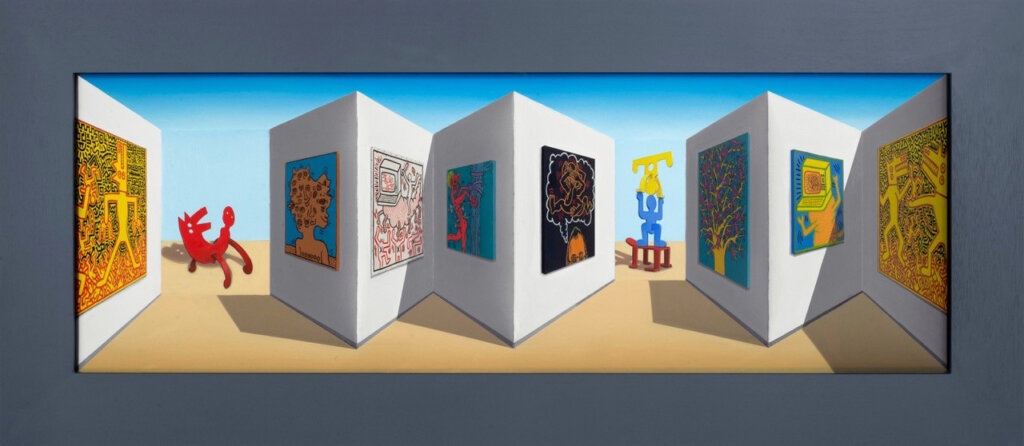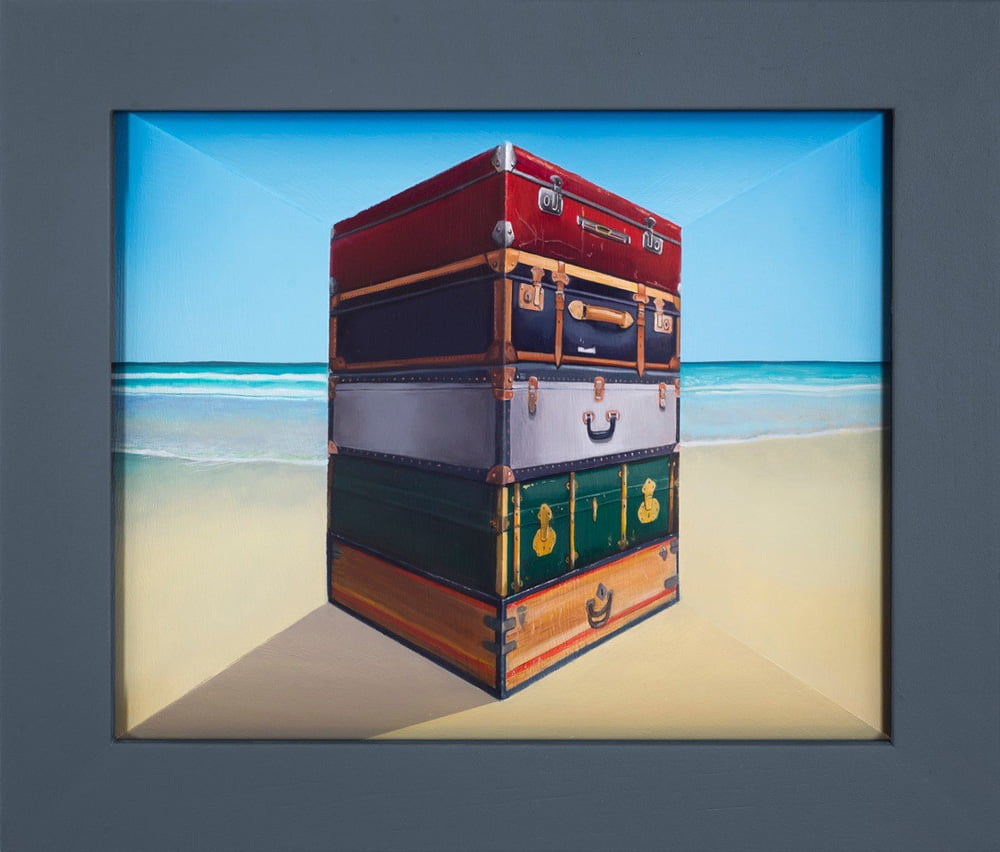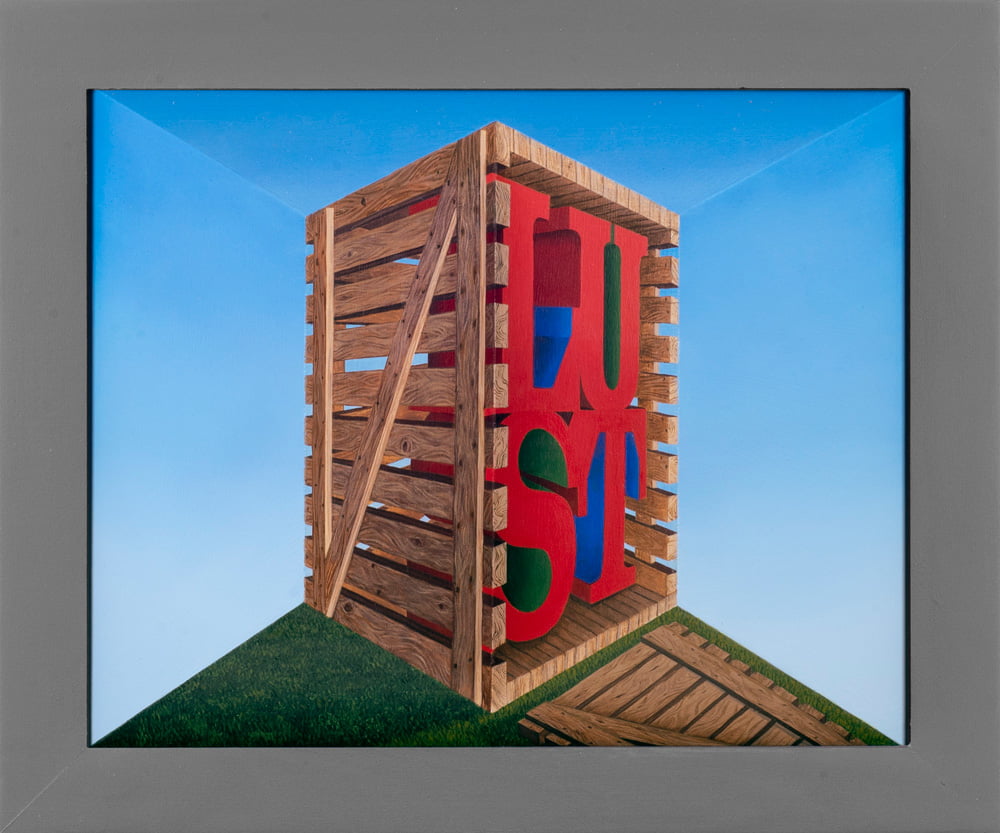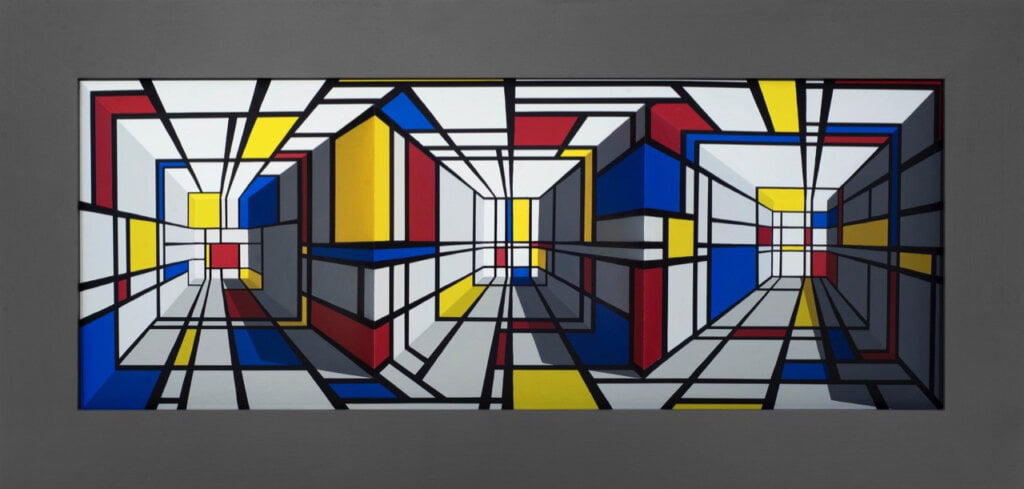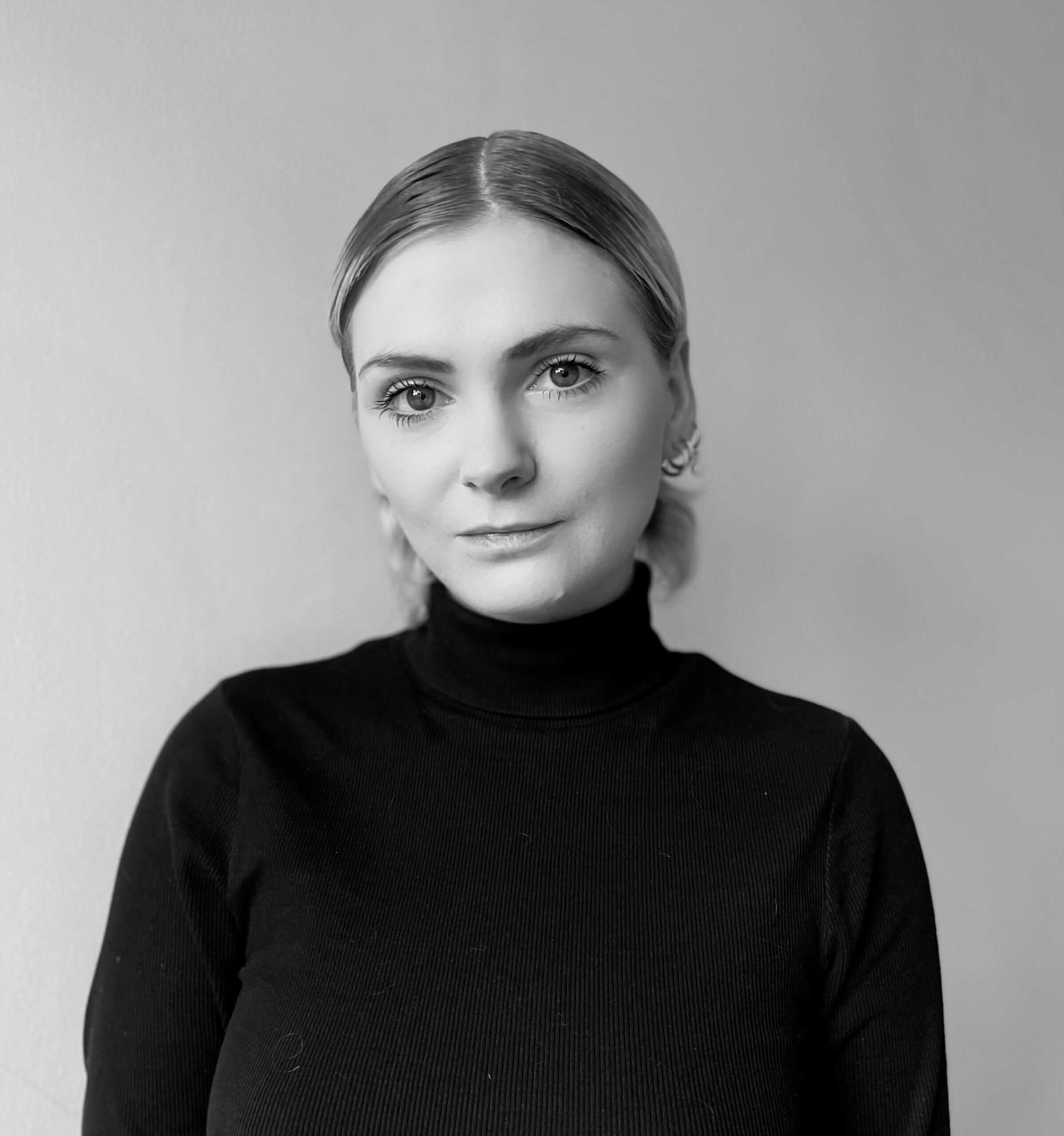Patrick Hughes is an eccentric artist and a total gentleman, always clad in stunning three-piece suits with a friendly smile and a soft, endearing voice. He is known for creating a technique known as Reverspective, which allows his paintings to appear animate in an optical illusion that makes you feel like you might have had one too many.
His is an acclaimed British artist who has lived and worked in the East End for the last twenty-five years, and has been a part of many monumental moments in the history of art. He was friends with Keith Haring, hung out with Warhol in New York and was one of the first artists on Angela Flowers roster.
There are many things that I would share, but sometimes I think the most profound thing that’s happened to me has been meeting other eccentric, misunderstood, or overlooked artists.
Patrick Hughes
I caught up with him on the phone, to reflect on his prolific sixty-year long career and his current solo show at Hang Up gallery in Hoxton. The feeling he left me with was one of joy and a reminder to value the important people who cross your path as it is them who shape your life.
Q: First, can you tell me a little about the exhibition at Hang Up. How did you select the works and what can people expect from the show?
A: I selected the works to ensure there would be a mixture of the various imagery and designs I have worked with through my career. There’s some Warhol, a Mondrian, a Haring, and a Banksy. There are also some suitcases, books, New York Store fronts and, of course, some rainbows.
Q: At the upcoming Hang Up Q&A evening you will be releasing a limited-edition print of Peggy. This is such a lovely piece; can you tell me about the humorous idea behind it?
A: I made the original of this work in 1963 using gloss paint on hardboard when I was a young pop artist of twenty-three or twenty-four. This work comes from my childlike sentiment to make some element of poetry out of the everyday. I noticed the way people hung their washing out on clotheslines with pegs and I thought I’ll jump my peg up onto the line and make him or her into a tightrope walker.
I think in the back of my mind were the little peg dolls poorer people used to make for their children. The legs of the peg were the legs of the doll, and the top of the peg was the head. Sometimes they even had a little frock. You can see them at the Museum of Childhood in Benthal Green.
I also always associated the work with one of Kafka’s Reflections on Sin, Pain, Hope and The True Way. The first of the aphorisms on The True Way says, “The true way goes over a rope which is not stretched at any great height but is just above the ground. It seems more designed to make people stumble than to be walked upon.”
Q:I like the way you described the peg as if it were a person.
A: Yes, my mother-in-law was called Peggy. I named the work in memory of her. Peggy is short for Margaret, and in a silly sort of way it’s nice to think of her standing on her clothesline.
Q: You are also going to have copies of your most recent book A Newer Perspective available at the Q&A. What are the central ideas explored in this text?
A: The book explores a variety of angles, from art history to the psychology of perception. Dawn Ades has written an essay on me as a student of surrealism. Martin Kemp is interested in perspective, geometry and art and he has written an essay exploring this aspect of my work. The third article is by Thomas Papahomas, who is a psychologist of perception. He writes about my work considered through the psychology of perception, exploring how we perceive and move in space.
I’ve also written a couple of articles for this book myself, one under my pseudonym Murray McDonald. In the interview between myself and Murray McDonald, he says “I’ve known Patrick since he was a student”…well, of course as he is me.
Q: Do you know what drew you into paradoxes, puns, and illusions – you’ve very interested in this world of inbetween meanings and incidences when things are not what they seem.
A: Honestly, I’m not sure why. Those sorts of things, circular arguments, contradictory arguments, and the logic of illogical things is something I’ve always been interested in somehow.
In my grandmother’s small sitting room there was a mirror above the fireplace and a mirror at the other side of the room and it reflected on into Infinity. So, as a child I was always interested in infinity and the idea that it’s irreducible. Like many of us, as a lonely bookish child you take interest in things that are odd or out of the way intriguing.
Q: I know that you’re a voracious reader, and I have no doubt that’s one of the activities that kept you occupied. But I was wondering what your experience was like of Lockdown. Were you able to keep creating and did it have a significant impact on your process?
A: In all honesty, it didn’t affect me much at all. From a practical point of view, sometimes people in my studio couldn’t come in so I just shipped work to them.
From the point of view of creativity, I went on as normal. Partly because four fifths of my life is already over. For those of us who are old, lockdown has taken a huge part of our lives. If you were a teenager, it might feel like a couple of years out of your remaining seventy or eighty. I didn’t think I could afford such a long break; I haven’t got many years left so I just carried on. I wouldn’t allow it to stop me.
Q: I can’t work out if that’s an optimistic or pessimistic way of looking at it. I imagine it’s both.
A:I think it’s a rational approach. I’m a rational irrationalist if you like.
Q: Am I right in thinking you have been showing artwork for the last sixty years in London, having a first show at Portal Gallery and further shows with Flowers Gallery?
A: When I was 21 in 1961, I showed at the Portal Gallery where my great hero René Magritte had shown. I showed with them for a couple of years and then at the Hanover Gallery, which was famous for finding Francis Bacon. After that I moved to what was then the Angela Flowers Gallery in 1970.
Q: During much of this time, the past twenty-five years, you have lived and worked in East London. What’s your relationship been like with the East End and would you say it has changed significantly since you’ve been there?
A: Yeah, it has changed a lot. I knew East End, as you suggest, through being with the Flowers Gallery for about twenty-five years before I moved here.
Somebody once asked me where I live when I was giving a talk, and I wanted to say in Hoxton or Shoreditch because I live on the border, but instead I said, “I live in Shockston or Whoreditch”. I made that spoonerism just because I was nervous, but I haven’t found it’s been a Whoreditch or a Shockston. It’s been rather cozy for me.
We were living here when there weren’t any shops, and when the first bar opened. We have seen enormous change. I’ve lived in places like Chelsea in New York, where it was gradually being gentrified. I’ve lived in Chelsea in London, which was also gradually gentrified. I’ve lived in some other places that have become rundown over the years like St Ives.
I’ve found it’s better to be somewhere that’s gradually being pulled up by its own bootstraps, than somewhere that’s going down the dumps. It’s good that we now have lots of shops and things like that, but broadly speaking, I don’t particularly notice my environment because I inhabit an ivory tower of my own thoughts.
Q: Many of your works are very referential and include iconic pieces of artwork by other creators. What method do you use to select the works to feature in your own? Is it based on artists you’ve had personal relationships with, or perhaps people you admire? Maybe you choose work you don’t particularly like?
A: I started by doing Mondrian because it was easy to draw, even though I didn’t like him. I thought he was a purist. Using only horizontals and verticals and primary colours seemed to me, rather miserable. Latterly, I’ve come around to quite liking him.
I used to do other artists like Rothko, also because it was possible to do in reverspective by hand. Certainly, putting something in the work doesn’t necessarily mean I like it. Much like if a still life painter makes pictures of bananas, it doesn’t mean he likes bananas. So, as you suggest, it isn’t always to do with what I like and more what will work for me.
When Photoshop was invented, suddenly I could include anything. Even with this, I only do 20th Century artists. Sometimes they are artists I have met like Man Ray, Méret Oppenheim and various people from the surrealist era.
I’ve met Warhol and Lichtenstein, and I was quite friendly at one time with Haring, so I guess I often put people that I know and like. I think Keith Haring’s work is terrific. Also, Jeff Koons balloon dog is wonderful because it’s a visual oxymoron, it’s meant to be soft and rubber and full of air and is actually steel and solid.
Q: There is a timeline ofThere is a timeline of significant moments from your career forming part of the exhibition at Hang Up. I was wondering if there are any personal memories that stand out to you, but perhaps are not included on the exhibition timeline?
A: Oh yes, some appalling love affairs and disasters of various kinds. There are many things that I would share, but sometimes I think the most profound thing that’s happened to me has been meeting other eccentric, misunderstood, or overlooked artists.
At one time, I very much enjoyed a close friendship with Ivor Cutler, the Scottish singer and poet. I loved Robin Page, the fluxus artist who had a green beard. I loved Anthony Earnshaw who was my friend in Yorkshire Surrealism and Assemblages. Those three people, unique in the in their behaviour and creativity, were wonderful to me. If I were to draw my own timeline, I would put in people like that who I have known and shared interests with.
See Patrick Hughes in conversation with Rosie Millard at Hang Up Gallery on Thursday 25th November. Doors open at 6.30pm. Exclusive edition of ‘Peggy’ available at a special price of £400.
Purchase a Exclusive edition of ‘Peggy’
https://www.instagram.com/patrickhughesartist/
©2021 Patrick Hughes
Art writer, curator and public relations specialist, focussed on platforming emerging talent across the visual culture sector. When not walking my dog in rainy East London parks, I can be found on my sofa writing articles for FAD magazine, Bricks Magazine, Art Plugged and Off the Block Magazine. Find me on Instagram @bellabonner




